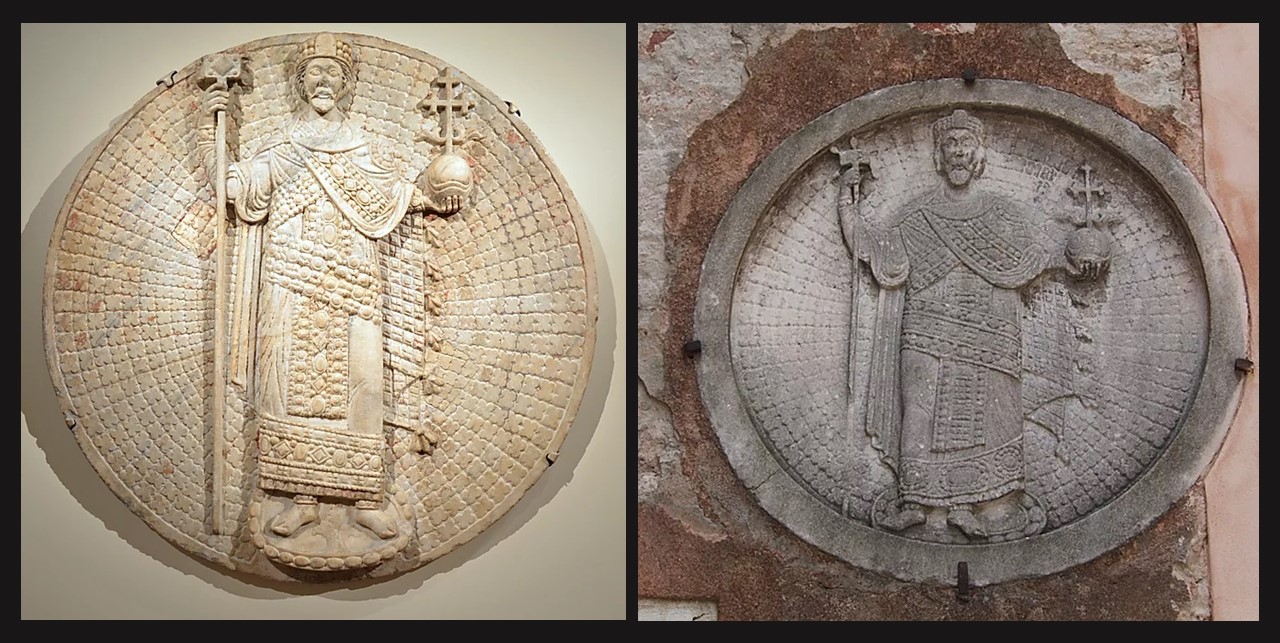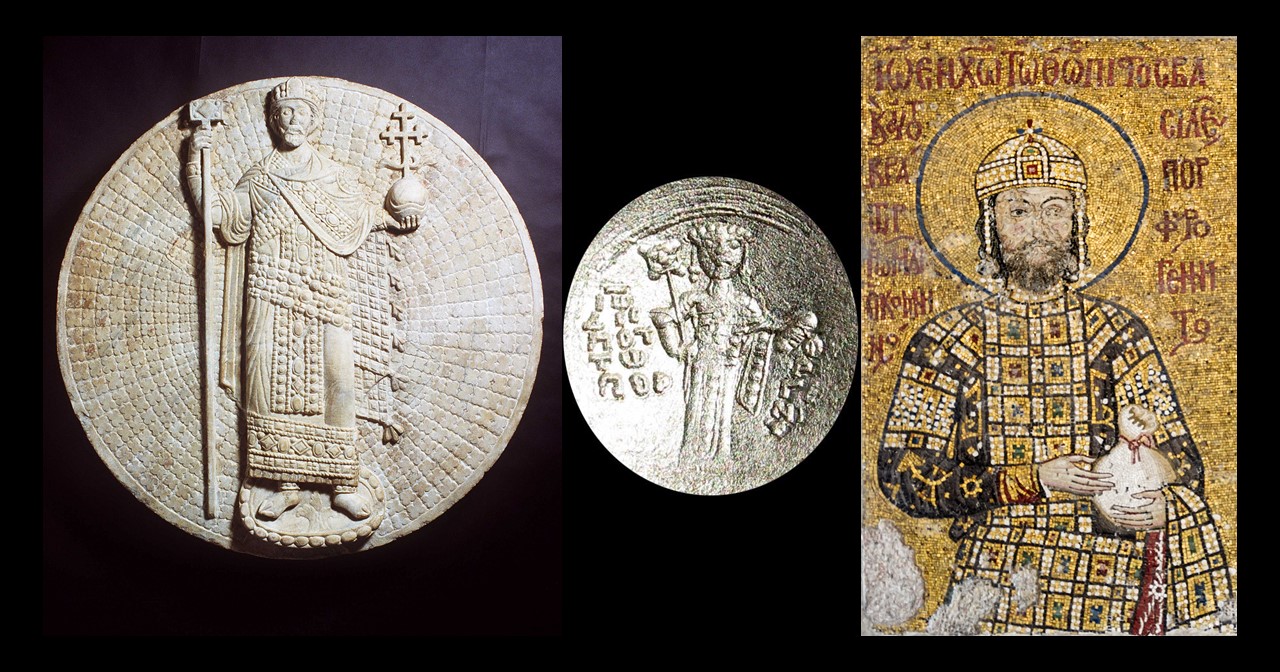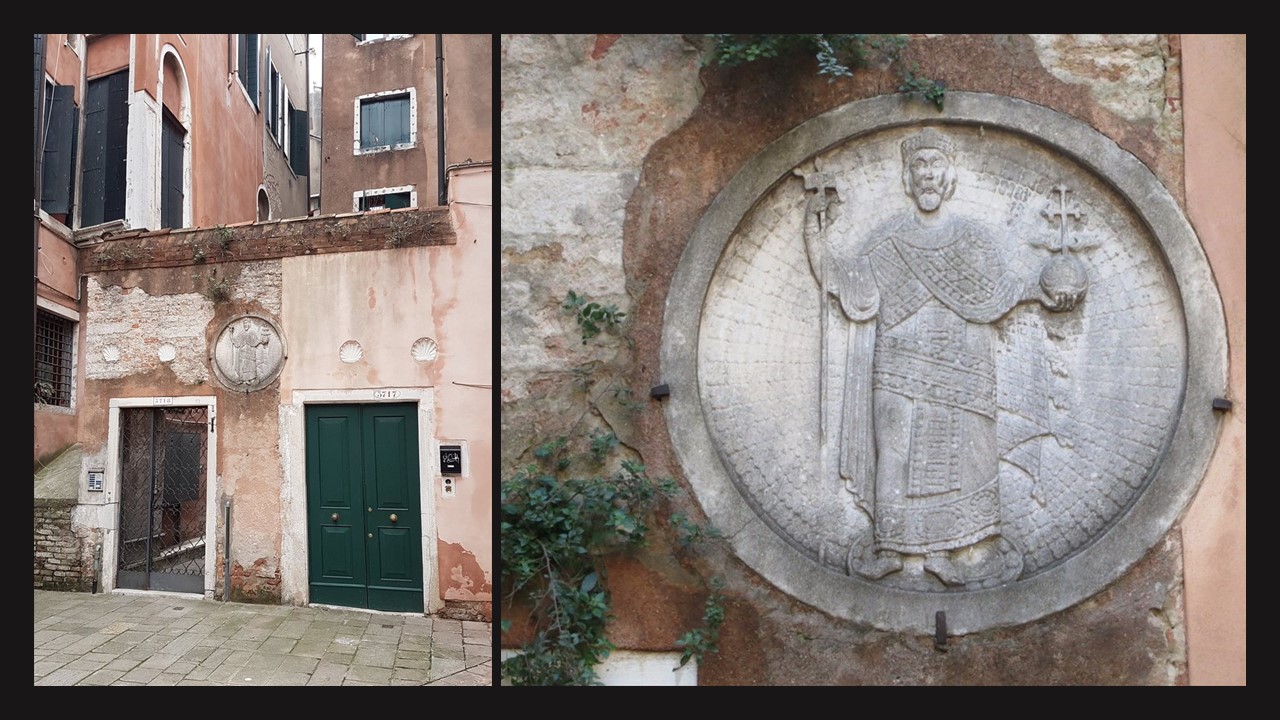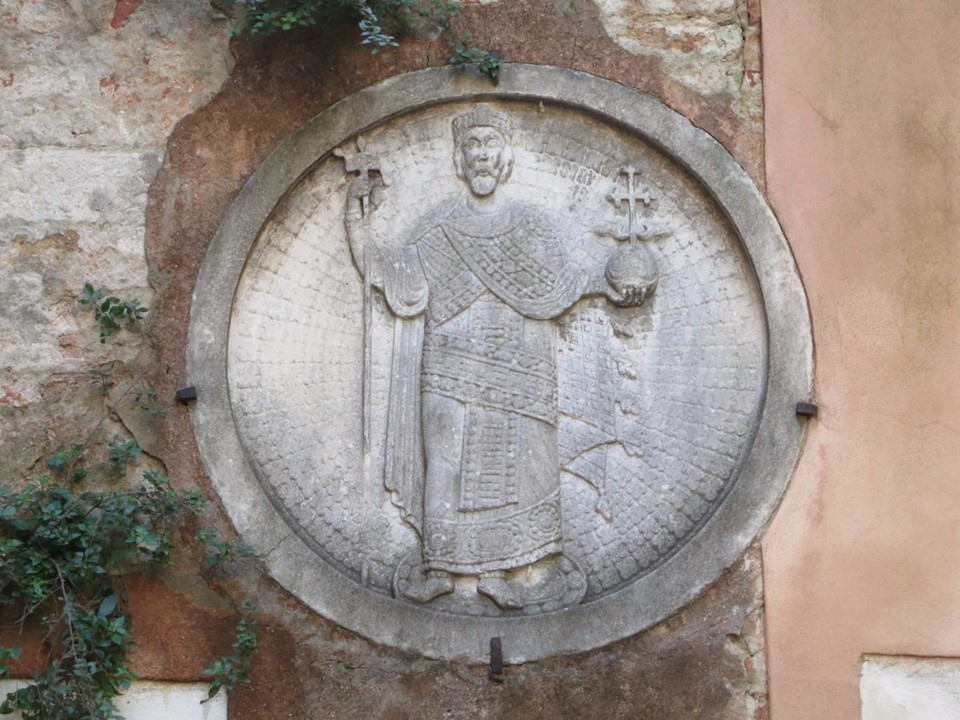
Angaran Roundel, marble, d. 100 cm,Campiello de Ca’Angaran, Dorsoduro in Venice
Parallel Stories of Byzantine Imperial Portraits is about our fascination with the ‘image’ of the Byzantine Emperor… “The Emperor had to conform to idealized standards of deportment. He had to be seen as fixed, stable, and unmovable, a ruler whose character and judgement were unswayed by emotional excess. Such a demeanor was described by the eleventh century courtier and orator Michael Psellos in a speech addressed to Isaac I Komnenos… You are straight, true, stiff… steadfast, firmly fixed, lofty… an impartial judge, unwavering in justice… a secure counselor, noble, unshaken in stormy waves. Psellos stressed the ruler’s lack of emotions: Where is there any anger in you, where are there streams of laughter, where are there traces of rage, and where is the babbling of speech? Where is there boasting, or violence and a willing mind? Where is there a knitting of the brows or an angry expression? For there are no unseemly qualities in you, neither easily excited emotions… nor delight, nor any graces, nor much laughter.” Writes Henry Maguire on IMAGES OF THE COURT in The Glory of Byzantium: Art and Culture of the Middle Byzantine Era, A.D. 843–1261, page 186 https://www.metmuseum.org/art/metpublications/The_Glory_of_Byzantium_Art_and_Culture_of_the_Middle_Byzantine_Era_AD_843_1261
Two Byzantine Emperors – Two Parallel Lives

Silver Aspron Trachy of John II Komnenos, 1118-1143 AD, Thessalonica mint, 3.69 grams, 29/27 mm, (Iω/ΔЄC/ΠΟT/Tω/ΠOP – ΦV/PO/ΓЄ/NH/T, the Emperor standing facing, wearing divitision and loros, holding labarum and akakia), private collection Copyright © 1998-2020, VHobbies.com
John II Comnenos, 1118, Komnenos Mosaic (John II Komnenos, Virgin Mary and Jesus Christ, Irene of Hungary), mosaic, Hagia Sophia Museum
Standing on a decorated suppedion, the Emperor of Byzantium at Dumbarton Oaks faces us in all his glory! He wears his ceremonial attire with poise and distinction: “a sagion (cape), bound at the right shoulder with a simple fibula, over a divitesion (tunic) and a loros (the gemmed scarf wrapped around the emperor’s torso.” Crowned and bejewelled, the Emperor stands in front of a vividly decorated background of cloverleaf arranged in a radiant design, holding the imperial insignia: “in his right hand he holds a labarum, a staff with a square finial” and in his left hand “an ornate globus cruciger with, in this instance, a leaved patriarchal cross.”
Who is the impressive Emperor depicted in this Byzantine relief sculpture Roundel exhibited today at the Dumbarton Oaks Museum of Byzantine Art? Is this a unique example of Byzantine imperial portraiture? The answer is NO! There is a second, matching Roundel in Venice, known as the Angaran Roundel, embedded on the exterior wall of a Venetian house in the Dorsoduro district, equally rare in Byzantine imperial representation. “It has been suggested that these two emperors are Alexios I and John II Komnenos, father and son, who reigned jointly between 1092 and 1118.”
Both Roundels, made of marble, date from the 12th century. For their creation, the unknown artist used a “marble piece of a horizontal slab that was cut from the top of a column shaft of unusually large diameter. The roundels therefore are reused architectural elements of an ancient monument of considerable size.” http://museum.doaks.org/OBJ27169.htm

The Angaran Roundel is almost identical to the one exhibited at the Dumbarton Oaks. Both depict Byzantine Emperors looking straight, true, stiff… steadfast, firmly fixed, lofty… holding the symbols of their power, gazing at us with majestic authority… but detached. Created by a great Constantinopolitan artist as an Imperial Ensemble, we can imagine, if this is a correct supposition, a third roundel with Christ in the middle. The Imperial Portraits somehow ended up in the Veneto area, most probably as the 4th Crusade loot. They were still in the Veneto until 1937 when Robert Woods Bliss acquired the one depicting Emperor John II, through Royall Tyler, who writes to Bliss “I went to Lugano yesterday, & saw the Emperor, who is magnificent… There’s no change in the amount (33,000). H.F. prefers to receive it direct… Volbach was wrong about the material of the Emperor. He is marble (not limestone): I should say he was of exactly the same light grey marble, not shiny, as the Campiello Angaran roundel, & he’s exactly the same in style & in every respect except a few details of costume (the loros is different), & details of the footstool… The chances are they came from Constantinople, as one doesn’t see why the Venetians should have representations of the Byz. Emperor made, when they had not long before shaken off his overlordship… I’m simply delighted that you’ve got this superb carving, the like of which is most unlikely to turn up again…” https://www.doaks.org/resources/bliss-tyler-correspondence/letters/25jul1937
On the 3rd of July, Ismail Safa Yalbaz, member of the Late Antique and Byzantine Studies Group, shared a POST on the Angaran Roundel that got me thinking… how many times have I been to Venice and missed visiting the Campiello de Ca’Angaran in Venice’s Dorsoduro district? I promised myself… next time in Venice, my respects to the Emperor will be the first thing to do!
For a Student Activity on the two Roundels, please… check HERE!
